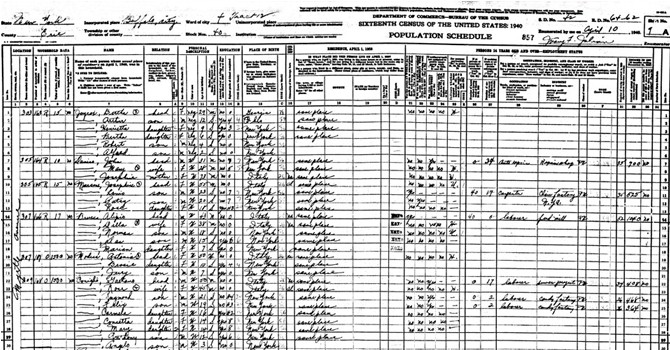
© 2015 50plus Senior News, All rights reserved.
The Search for Our Ancestry: The 1940 Census
Angelo Coniglio | Jul 16, 2012, 6 a.m.

The United States Census has been taken every 10 years since 1790. It is used by the federal government for a variety of reasons, the primary one being to establish Congressional districts according to population. For protection of privacy, the census is not made public until 72 years after it is taken.
Thus, this is the first U.S. census in which my name appears, as well as the names of many 50plus Senior News readers. Publication of the 1940 U.S. census has been a highly anticipated event by genealogists. It has also sparked an awareness in those who may not be that interested in the history of ancestors they never knew—because they can now find information they mat not have known about their parents or even themselves.
The 1940 census was the first taken after the start of Social Security, the first after the Great Depression, and the last before the nation’s entry into World War II. It holds many nuggets of information about the “Greatest Generation.”
Many of the questions on the 1940 census are the standard ones: name, age, gender, race, education, and place of birth. But the 1940 census also asked many new questions. The instructions directed the enumerator to enter an X after the name of the person furnishing the information about the family; whether the person worked for the CCC, WPA, or NYA the week of March 24-30, 1940; and income for the 12 months ending Dec. 31, 1939.
The 1940 census also has a supplemental schedule for two names on each page. The supplemental schedule asks the place of birth of the person’s father and mother; the person’s usual occupation, not just what they were doing the week of March 24-30, 1940; and for all women who are or have been married, if this woman has been married more than once and age at first marriage.
The 1940 census is available online at several sites, including the free National Archives (NARA) (www.archives.gov/research/census/1940); the free LDS site (www.familysearch.org/1940census); and the subscription site Ancestry.com.
The demand for the NARA site has been so great that the 1940 census has been unavailable at the site while it was being reposted. It may be available by press time. Currently, all three sites are working feverishly to “index” the 1940 census: that is, to digitize the information so that users may search those databases by using the name of the person they are researching. Before that work is completed, the records must be “browsed,” or reviewed, page by page.
That is not as daunting as it sounds, since federal censuses are recorded in a very organized manner, by state, county, town, and census “enumeration district” (ED). “Fine,” you may say, “but how do I know what enumeration district my parents lived in when I was born?”
The task is made easier by that great friend of genealogical researchers, Stephen Morse. He has created a page (www.stevemorse.org/census/unified.html) that will help you find any enumeration district, if you have at least some idea of the address you’re researching.
If you’re not sure of the bounding streets, use a service such as Mapquest or Google Earth to find the street address, and then make a note of the streets that define the surrounding city block. Then enter them on the Stephen Morse site. An enumeration district number will be shown as a “live” link. Click on that link, and you will see links for five sites at which the records can be viewed, including the three mentioned above.
The resulting ED may have 20 to 30 census pages that must be browsed until you find what you’re looking for—not really that boring a task, as you’re likely to awaken fond memories when you see the names of nearby families, including those of neighborhood kids you knew as a child.
Readers: I’m excited to announce that my first published book, The Lady of the Wheel (La Ruotaia), is now available. It’s historical fiction based on my genealogical research of Sicilian foundlings. See my page about it at www.bit.ly/ruotaia.
|
Write to Angelo at genealogytips@aol.com or visit his
website, www.bit.ly/AFCGen.
He is the author of the book The Lady of the Wheel (La Ruotaia), based on his genealogical research of Sicilian foundlings. For more information, see www.bit.ly/SicilianStory. |





